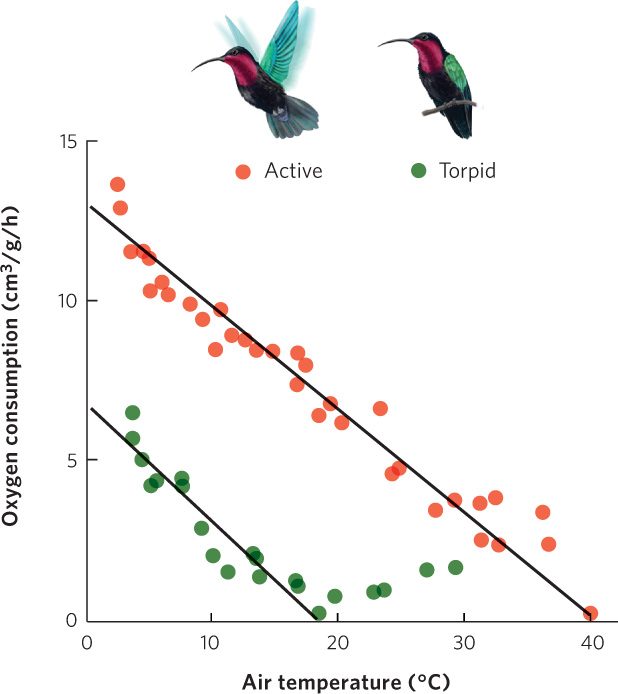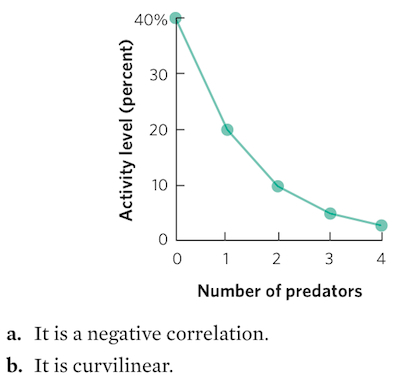Migration, storage, and dormancy are strategies to survive extreme environmental variation
In many parts of the world, extremes of temperature, drought, darkness, and other adverse conditions are so severe that individuals either cannot change enough to maintain their normal activities, or the change required would not be worth the cost. Under such conditions, organisms resort to a number of extreme phenotypically plastic responses. These include migration, storage, and dormancy.
Migration
Migration is the seasonal movement of animals from one region to another. In this case, the phenotype is the behavior of living in a particular location and the plasticity is displayed in the act of migrating, which allows the animal to express the alternative phenotypes of living in multiple locations. Each fall, hundreds of species of land birds leave temperate and Arctic North America, Europe, and Asia for the south, in anticipation of cold winter weather and dwindling food supplies. In east Africa, many large herbivores, such as wildebeests (Connochaetes taurinus), migrate long distances, following the geographic pattern of seasonal rainfall and fresh vegetation. Some insects also migrate. Monarch butterflies offer a fascinating example of insect migration, as shown in Figure 4.13. The adult butterflies living in the northern United States and southern Canada migrate to wintering areas in the southern United States and Mexico. Here they hibernate through the winter and then begin heading back north. On their way north, they breed and produce a second generation of butterflies. This second generation completes the migration back to the summer breeding areas. In all cases, the decision to migrate is a plastic behavior in response to environmental changes. For these animals, migration is a better strategy than staying put in either location year-round.

100
Some migratory movements occur in response to reductions in local food supplies. For example, locust migrations occur when the insects leave an area where they have a large population and a depleted food supply. The migrations can reach immense proportions and cause extensive crop damage over wide areas. This migratory behavior in locusts is the result of a number of behavioral changes. In sparse populations, adult locusts are solitary and sedentary. In dense populations, however, frequent contact with other locusts stimulates young individuals to develop gregarious, highly mobile behavior, which can grow into a mass migration.
Storage
Where environmental variation shifts the food supply from feast into famine and migration is not a possibility, storage of resources can be an adaptive strategy. For example, during infrequent rainy periods, desert cacti swell with water stored in their succulent stems, as discussed in Chapter 3. In habitats that frequently burn—such as the chaparral of southern California—perennial plants store food reserves in fire-resistant root crowns, shown in Figure 4.14. The surviving root crowns send up new shoots shortly after a fire has passed.

Many temperate and Arctic animals accumulate fat during mild weather as a reserve of energy for periods of harsher weather when snow and ice make food inaccessible. However, fat reserves can make an animal slower and less agile, and therefore more likely to be caught by predators. One way to avoid this problem is to store the food before consuming it. Some mammals and birds that are active during the winter—for example beavers, squirrels, pikas, acorn woodpeckers, and jays—cache food supplies underground or under the bark of trees for later retrieval. These caches can be large enough to sustain individuals for long periods.
Dormancy
Dormancy A condition in which organisms dramatically reduce their metabolic processes.
Environments sometimes become so cold, dry, or depleted of nutrients that organisms can no longer function normally. Some species that do not migrate have evolved a strategy of dormancy, a condition in which they dramatically reduce their metabolic processes. One of the most obvious forms of dormancy occurs when many temperate and Arctic trees shed their leaves in the fall before the onset of winter frost and long nights. Similarly, many tropical and subtropical trees shed their leaves during seasonal periods of drought. Plant seeds and spores of bacteria and fungi also exhibit dormancy. Indeed, there are many cases in which researchers have sprouted seeds recovered from archeological excavations where the seeds have been dormant for hundreds of years. There are four types of dormancy: diapause, hibernation, torpor, and aestivation.
Diapause A type of dormancy in insects that is associated with a period of unfavorable environmental conditions.
In most species, worsening environmental conditions are anticipated and individuals proceed through a series of physiological changes that prepare them for a partial or complete physiological shutdown. Diapause is a type of dormancy that is common in insects in response to unfavorable environmental conditions. For example, as winter approaches, insects shut down their metabolism to barely detectable levels. In doing so, the insects need to either reduce the quantity of water in their bodies or chemically bind the water in their bodies to prevent freezing. Similarly, insects facing drought conditions can enter a summer diapause by dehydrating themselves. They either tolerate the desiccated condition of their bodies or secrete an impermeable outer covering to prevent further drying.
101
Hibernation A type of dormancy that occurs in mammals in which individuals reduce the energetic costs of being active by lowering their heart rate and decreasing their body temperature.
During hibernation, a less extreme type of dormancy that occurs in mammals, animals reduce the energetic costs of being active by lowering their heart rate and decreasing their body temperature. Many mammals, including ground squirrels and bats, hibernate during seasons when they are unable to find food (Figure 4.15). Prior to hibernation, the animal consumes enough food to produce a thick layer of fat that provides the energy necessary to survive the hibernation period without eating.

Torpor A brief period of dormancy that occurs in birds and mammals in which individuals reduce their activity and their body temperature.
Some types of dormancy occur over short periods of time to deal with cold temperatures. At low air temperatures, some birds and mammals are not able to maintain a high body temperature. To maintain a high body temperature would require that the animal burn up its stored energy faster than it can consume and digest the food needed to replace the energy lost in creating body heat. In this situation the animal might go into a brief period of dormancy, known as torpor, during which the animal reduces its activity and its body temperature decreases. During torpor, reduced activity and reduced body temperature help conserve energy. Torpor may last as little as a few hours or extend for a few days and is a voluntary, reversible condition.
Many small birds and mammals use torpor. Hummingbirds, a group of tiny birds with body lengths of 7.5 to 13 cm, provide a good example. These small birds have a high surface to volume ratio. This causes a rapid loss of heat across the body surface relative to the volume of body that can produce heat. As the air temperature declines, hummingbirds must metabolize increasing amounts of energy to maintain a resting body temperature near 40°C. Figure 4.16 shows the relationship between air temperature and energy needs for the West Indian hummingbird (Eulampis jugularis), with its metabolic rate measured as the amount of oxygen consumed as it converts its stored energy into body heat. When the bird enters torpor, it reduces its resting body temperature by 18°C to 20°C. If the air temperature drops to 20°C, torpor allows the bird to stop burning extra energy to generate body heat and thereby conserve its energy reserves. Torpor does not mean that the animal ceases to regulate its body temperature; it merely changes the set point on its thermostat to reduce the difference between ambient and body temperature, and thereby reduces the energy expenditure needed to maintain its temperature at the set point.

102
ANALYZING ECOLOGY
Correlations
Correlation A statistical description of how one variable changes in relation to another variable.
In the hummingbird example, we saw that as air temperature decreased, the bird’s consumption of oxygen increased (Figure 4.16). This is an example of a statistical correlation. A correlation is a statistical description of how one variable changes in relation to another variable. For example, at the beginning of this chapter, we observed that when tadpoles faced more dangerous predators they exhibited larger phenotypic changes. Similarly, in our discussion of environmental variation, we noted that the size of the area affected by an event such as tornadoes or hurricanes correlated with the duration of the event (Figure 4.3).
Two variables can be related to each other in a variety of ways, shown in the graphs below. A positive correlation (a) indicates that as one variable increases in value, the second variable also increases. A negative correlation (b) indicates that as one variable increases in value, the second variable decreases. Such increases or decreases may be linear, meaning that the data fall along a straight line, as shown in the example. They may also be curvilinear, as shown in (c) and (d), meaning that the data follow a curved line.
Correlations do not tell us anything about causation. For example, the positive correlation between variable A and variable B in panel (a) might occur because a change in variable A causes the change in variable B. But it could also be that a change in variable B causes the change in variable A. Alternatively, a third, unmeasured variable might cause both A and B to change.
Consider the case of humans climbing Mount Everest. As a person climbs up the mountain over several weeks, the temperature continually decreases and the climber’s efficiency in obtaining oxygen from the air increases. This is a correlation, but it is not causation. Lower temperatures do not cause a person to acquire oxygen more efficiently. We know that a third variable, the declining oxygen pressure at high altitudes, is the real cause of the increased efficiency in obtaining oxygen from the air.




103
Aestivation The shutting down of metabolic processes during the summer in response to hot or dry conditions.
A fourth type of dormancy is aestivation, which is the shutting down of metabolic processes during the summer in response to hot or dry conditions. Well-known aestivating animals include snails, desert tortoises, and crocodiles.
By whatever mechanism it occurs, dormancy reduces exchange between organisms and their environments, enabling animals and plants to survive unfavorable conditions.
Adaptations to Prevent Freezing
In Chapter 2 we discussed the adaptations that some aquatic animals have to avoid the damaging effects that freezing can cause to their tissues. In a similar fashion, some terrestrial animals survive very cold weather on land by using special adaptations, including the production of antifreeze chemicals that prevent or control the formation of ice crystals. For example, in cold northern climates many insects spend the winter living just beneath the bark of trees. This bark helps insulate insects to some degree, but they still experience temperatures below the freezing point of water. Similarly, many species of amphibians spend the winter buried a short distance below the soil surface. This location exposes the amphibians to below freezing temperatures. These animals can freeze solid underground in a state that requires very little metabolic activity (Figure 4.17). Two strategies—the use of antifreeze chemicals and forming ice crystals between rather than within cells—help insects and amphibians avoid tissue damage and are an important element in the dormancy of many species during cold weather. As temperatures warm in the spring, the animals slowly thaw out and resume their normal activities.

Migration, storage, and dormancy represent phenotypically plastic strategies that allow organisms to cope with extreme changes in their environment. Such behavioral and physiological flexibility provides a substantial selective advantage.